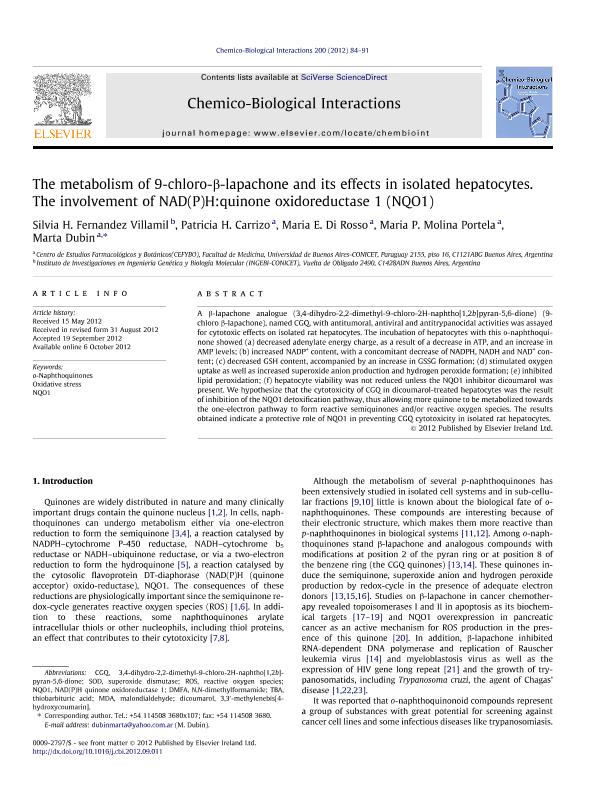Artículo
The metabolism of 9-chloro-β-lapachone and its effects in isolated hepatocytes. The involvement of NAD(P)H:quinone oxidoreductase 1 (NQO1)
Fernandez Villamil, Silvia Hebe ; Carrizo, Patricia H.; Di Rosso, María Emilia
; Carrizo, Patricia H.; Di Rosso, María Emilia ; Molina Portela, María P; Dubin, Marta
; Molina Portela, María P; Dubin, Marta
 ; Carrizo, Patricia H.; Di Rosso, María Emilia
; Carrizo, Patricia H.; Di Rosso, María Emilia ; Molina Portela, María P; Dubin, Marta
; Molina Portela, María P; Dubin, Marta
Fecha de publicación:
12/2012
Editorial:
Elsevier Ireland
Revista:
Chemico-biological Interactions
ISSN:
0009-2797
Idioma:
Inglés
Tipo de recurso:
Artículo publicado
Clasificación temática:
Resumen
A β-lapachone analogue (3,4-dihydro-2,2-dimethyl-9-chloro-2H-naphtho[1,2b]pyran-5,6-dione) (9-chloro β-lapachone), named CGQ, with antitumoral, antiviral and antitrypanocidal activities was assayed for cytotoxic effects on isolated rat hepatocytes. The incubation of hepatocytes with this o-naphthoquinone showed (a) decreased adenylate energy charge, as a result of a decrease in ATP, and an increase in AMP levels; (b) increased NADP+ content, with a concomitant decrease of NADPH, NADH and NAD+ content; (c) decreased GSH content, accompanied by an increase in GSSG formation; (d) stimulated oxygen uptake as well as increased superoxide anion production and hydrogen peroxide formation; (e) inhibited lipid peroxidation; (f) hepatocyte viability was not reduced unless the NQO1 inhibitor dicoumarol was present. We hypothesize that the cytotoxicity of CGQ in dicoumarol-treated hepatocytes was the result of inhibition of the NQO1 detoxification pathway, thus allowing more quinone to be metabolized towards the one-electron pathway to form reactive semiquinones and/or reactive oxygen species. The results obtained indicate a protective role of NQO1 in preventing CGQ cytotoxicity in isolated rat hepatocytes.
Palabras clave:
O-Naphthoquinones
,
Oxidative Stress
,
Nqo1
Archivos asociados
Licencia
Identificadores
Colecciones
Articulos(CEFYBO)
Articulos de CENTRO DE ESTUDIOS FARMACOLOGICOS Y BOTANICOS
Articulos de CENTRO DE ESTUDIOS FARMACOLOGICOS Y BOTANICOS
Articulos(INGEBI)
Articulos de INST.DE INVEST.EN ING.GENETICA Y BIOL.MOLECULAR "DR. HECTOR N TORRES"
Articulos de INST.DE INVEST.EN ING.GENETICA Y BIOL.MOLECULAR "DR. HECTOR N TORRES"
Citación
Fernandez Villamil, Silvia Hebe; Carrizo, Patricia H.; Di Rosso, María Emilia; Molina Portela, María P; Dubin, Marta; The metabolism of 9-chloro-β-lapachone and its effects in isolated hepatocytes. The involvement of NAD(P)H:quinone oxidoreductase 1 (NQO1); Elsevier Ireland; Chemico-biological Interactions; 200; 2-3; 12-2012; 84-91
Compartir
Altmétricas



